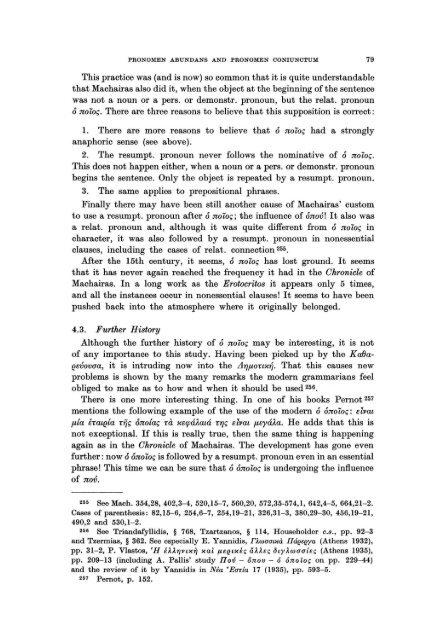Pronomen Abundans and Pronomen Coniunctum. A ... - DWC
Pronomen Abundans and Pronomen Coniunctum. A ... - DWC
Pronomen Abundans and Pronomen Coniunctum. A ... - DWC
You also want an ePaper? Increase the reach of your titles
YUMPU automatically turns print PDFs into web optimized ePapers that Google loves.
PRONOMEN ABUNDANS AND PRONOMEN CONIUNCTUM: 79<br />
This practice was (<strong>and</strong> is now) so common that it is quite underst<strong>and</strong>able<br />
that Machairas also did it, when the object at the beginning of the sentence<br />
was not a noun or a pers. or demonstr. pronoun, but the relat. pronoun<br />
Ó noloç. There are three reasons to believe that this supposition is correct:<br />
1. There are more reasons to believe that Ó noloç had a strongly<br />
anaphoric sense (see above).<br />
2. The resumpt. pronoun never follows the nominative of Ó noioç.<br />
This does not happen either, when a noun or a pers. or demonstr. pronoun<br />
begins the sentence. Only the object is repeated by a resumpt. pronoun.<br />
3. The same applies to prepositional phrases.<br />
Finally there may have been still another cause of Machairas' custom<br />
to use a resumpt. pronoun af ter ó noioç; the influence of ónov! It also was<br />
arelat. pronoun <strong>and</strong>, although it was quite different from ó noioç in<br />
character, it was also followed by a resumpt. pronoun in nonessential<br />
clauses, including the cases of relat. connection 255.<br />
Mter the 15th century, it seems, ó noioç has lost ground. It sooms<br />
that it has never again reached the frequency it had in the Chronicle of<br />
Machairas. In a long work as the Erotocritos it appears only 5 times,<br />
<strong>and</strong> all the instances occur in nonessential clauses! It seems to have been<br />
pushed back into the atmosphere where it originally belonged.<br />
4.3. Further History<br />
Although the further history of ó noioç may be interesting, it is not<br />
of any importance to this study. Having been picked up by the Ka()aeevovC1a,<br />
it is intruding now into the LJ'YJfl0itx'fJ. That this causes new<br />
problems is shown by the many remarks the modern grammarians feel<br />
obliged to make as to how <strong>and</strong> when it should be used 256.<br />
There is one more interesting thing. In one of his books Pernot 257<br />
mentions the following example of the use of the modern Ó ónoioç: elvat<br />
flta hateta TfjÇ ónotaç Tà xecpá).atá T'YJÇ elvat fleyáï..a. He adds that this is<br />
not exceptional. If this is really true, then the same thing is happening<br />
again as in the Chronicle of Machairas. The development has gone even<br />
further: now ó ónoioç is followed by a resumpt. pronoun even in an essential<br />
phrase! This time we can be sure that ó ónoioç is undergoing the influence<br />
of nov.<br />
255 See Mach. 354,28,402,3-4,520,15-7,560,20,572,35-574,1, 642,4-5, 664,21-2.<br />
Cases of parenthesis : 82,15-6, 254,6-7, 254,19-21, 326,31- 3, 380,29-30, 456,19-21,<br />
490,2 <strong>and</strong> 530,1-2.<br />
256 See Tri<strong>and</strong>afyllidis, § 768, Tzartzanos, § 114, Householder C.S., pp. 92- 3<br />
<strong>and</strong> Tzermias, § 362. See especially E. Yannidis, r;.waa,~à IJá(!e(!ya (Athens 1932),<br />
pp_ 31-2, P. Vlastos, 'H o.Ä1JV'~", ~al ,jf:(!,~èç äHeç ö'yÄwaaieç (Athens 1935),<br />
pp. 209-13 (including A_ Pallis' study IJ ov - önov - ó óno ioç on pp. 229- 44)<br />
<strong>and</strong> the review of it by Yannidis in NÉa 'Ecnia 17 (1935), pp. 593-5.<br />
257 Pernot, p_ 152_
















